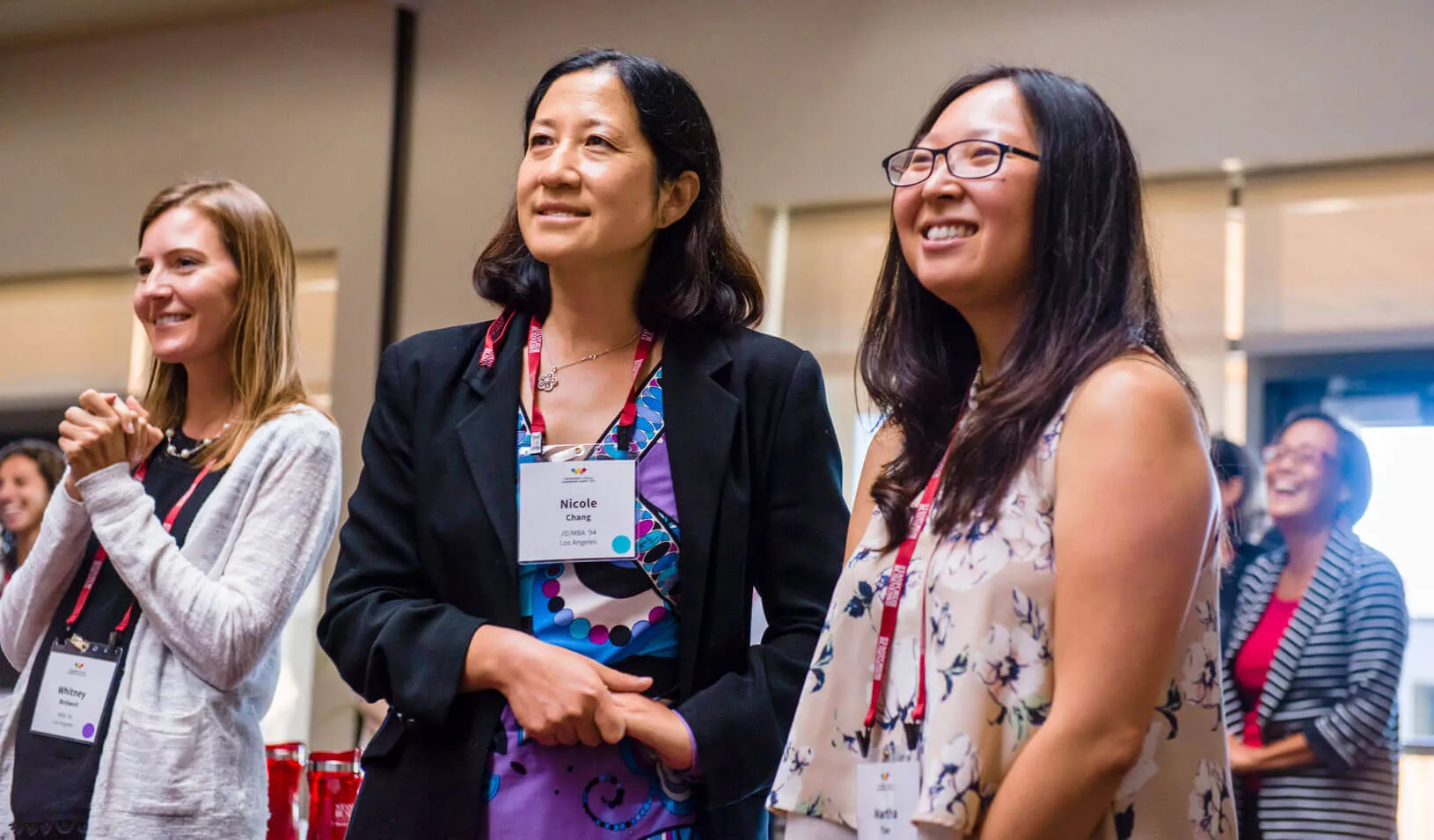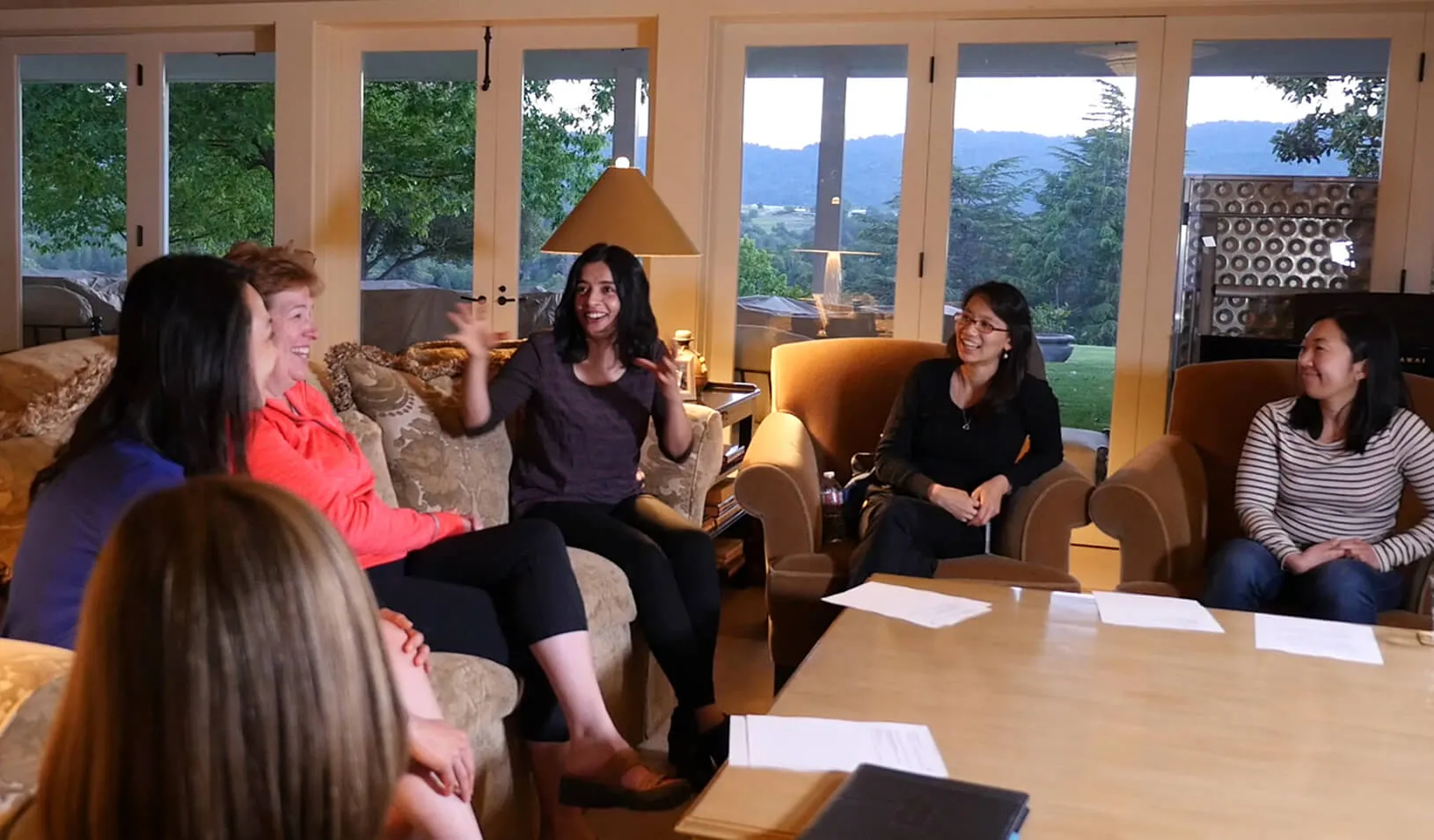Women’s Circles Support Stanford GSB Alumnae Through the Arc of Their Lives
The first Women’s Circles Leadership Summit celebrates and educates alumnae who share their personal and professional experiences across generations.
October 04, 2017

On Sept. 8 and 9, 2017, group co-leaders and regional team leaders gathered on campus to attend the first Stanford GSB Women’s Circles Leadership Summit. | Toni Bird
The challenges that female leaders face are daunting.
Studies show that women on the job typically face a higher bar and endure extra scrutiny when being evaluated, are more likely to receive vague feedback in reviews, and often confront the double bind of being perceived as either likable but incompetent or competent but unlikable, according to Caroline Simard, the senior director of research at Stanford University’s Michelle R. Clayman Institute for Gender Research. Add to this the fact that studies indicate that people are often unaware when they are swayed by gender bias, and it is tempting to become discouraged.
One way to counter these forces is to enable women, especially those across generations, to support each other, open up dialogues, and learn more about the challenges they face. That is one of the reasons graduates of Stanford Graduate School of Business set out in 2013 to form Women’s Circles, with the goal of growing a community of thriving alumnae.

K. Danae Pauli, MBA ’12 (left), and Michelle Clayman, MBA ’79, launched Stanford GSB Women’s Circles in 2013. | Toni Bird
Over 50 Stanford GSB Women’s Circles are now offered in 10 geographic regions across the country and in the United Kingdom. And they are working.
“My Women’s Circle is a great sounding board for decisions and a source of support,” says one member. “It’s like having my own board of directors.”
Founded by Michelle Clayman, MBA ’79, and K. Danae Pauli, MBA ’12, the program provides women with personal and professional support through monthly meetings of diverse, intergenerational groups of six to eight women. The circles are organized by 108 volunteer group co-leaders and regional leaders.
Across Generations, Across Transitions
To foster the growth of the program, its participants, and its leaders, the first Stanford GSB Women’s Circles Leadership Summit took place on campus on Sept. 8 and 9, drawing 65 attendees.
“Circles is our fastest-growing alumni program,” said Stanford GSB Dean Jonathan Levin in kicking off the summit on Friday afternoon. “It is providing hundreds of GSB alumnae with a way to share experiences and support, and we are very excited to expand it further,” he noted, adding that circles will be newly offered in Houston and Boston this fall.
The growing number of participants, Clayman observed in her introductory remarks, shows that women are seeking a lifelong resource “to help them both to thrive and to lead their best possible lives, however they define thriving.”
Circles provides support to women from the time they graduate from the business school through the arc of their lives. This can be particularly useful during career and life transitions, common times of struggle.
“Women come to inflection points in their life for either professional or personal reasons, and they make decisions that change their trajectory,” Clayman said. The point of the Circles program is “to help people through those transitions, because we have this whole pool of wisdom from generations of alumnae who have come through the school.”

Women’s Circles are small groups of GSB alumnae who gather monthly to talk about their lives in the interest of connecting, reflecting, and supporting and inspiring one another. | Beth Charlesworth
Younger women learn vital information from older alumnae, who can offer advice based on the knowledge they have acquired through experience. Clayman recalled recently advising an alum who was on maternity leave during the census for her company’s profit-sharing plan, and was concerned because she would miss out for the year. Clayman, the trustee for her own company’s plan, explained that the rule is laid down by law, but suggested that the new mom might be able to negotiate for something else she wanted from her company.
At the same time, “it isn’t just about older women giving advice to younger women,” Pauli noted at the summit. “Women come to the table as peers,” she said, elaborating on how older Circles members “say that they learn so much from younger alums — that they learn how to relate to younger people and are inspired by their energy and optimism.”
Summit Learnings
To acquire more tools to lead Circles, leaders at the summit learned new concepts from Stanford faculty and explored new facilitation tools.
Adina Sterling, Stanford GSB assistant professor of organizational behavior, told the summit participants that one way to counteract gender bias is for companies to hold “tryouts,” allowing company managers to observe individuals firsthand for a period of time. This allows job candidates to demonstrate how well they can perform, says Sterling, and narrows the gap in initial salaries for professionally trained managers.
Bias is “an error in decision-making,” said the Clayman Institute’s Simard, who explored the language of leadership at the summit. Stereotypes, too, often function as “cognitive shortcuts that affect the standard we use to evaluate the performance of individuals.” That’s why objective and intentional job-assessment criteria can help.
Mary Ann Huckabay, Stanford GSB lecturer in organizational behavior, emeritus, led an activity intended to help women learn how to communicate across generations, which in effect decreases stereotyping and “allows us to see one another as unique people.”
By the conclusion of the weekend, the summit had completed a circle of its own, with Stanford faculty members helping leaders to help in turn the alumnae who come to the groups for advice, coaching, and strength. Says Pauli, “We want our alumnae to be happy about their professional and personal lives, and feel that Stanford GSB helped them get there.”
Join a Stanford GSB Women’s Circle.
— Marcie Bianco
For media inquiries, visit the Newsroom.
Explore More
Pedro Siciliano, MBA ’24: Giving Teachers the Time to Teach

A Conversation with Interim Dean Peter DeMarzo

Stanford Impact Founder Awards Fuel Graduates’ High-Impact Ventures
